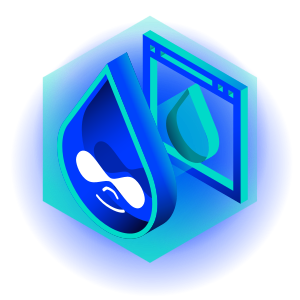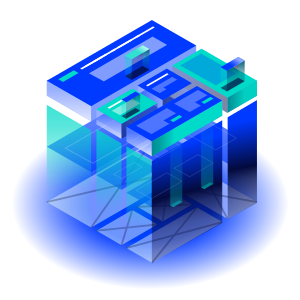
Drupal 11 - Release Date, Features, and What to Expect
In 2024, Drupal 11, the latest version of the popular content management system, was released. The new edition brought significant changes, such as an intuitive administrative interface and ready-made configuration sets (Recipes). Thanks to automatic updates, the system has also become more secure and easier to maintain. In this article, you will learn why you should choose Drupal 11 or upgrade your current website to it.
In this article:
- Drupal 11 release date
- New features in Drupal 11
- Drupal CMS
- Drupal 10 vs 11
- Installation and first steps – Drupal CMS, Droopler, Open Intranet
- Drupal 11 – summary
Drupal 11 release date
Drupal 11 is the latest version of one of the most popular content management systems, released on August 2, 2024. Eagerly awaited by the Drupal community, "eleven" brought many changes compared to version 10, ushering in a new era in the development of this CMS.
However, version 11.0.0 was just the beginning. On December 16, 2024, the first functional version was released – Drupal 11.1.0, which brought significant improvements to the Recipes system, support for hooks written as classes, and increased flexibility of the Workspaces module.
New release cycle
Drupal 11 introduces a new, more predictable Drupal core release schedule. The plan is to release a new major version of Drupal every two years, with each major version receiving active support for approximately two years, followed by technical support and security for another two years. This means significantly longer support periods than previous versions.
Drupal 10 will be supported until the release of Drupal 12, planned for the second half of 2026. Support for Drupal 10 will end on December 9, 2026, giving users more than two years to prepare for upgrading.
New features in Drupal 11
Drupal 11 introduces many powerful new features that make it an even better tool for building websites. These changes significantly improve the security, performance, and usability of this content management solution. Let's learn more about them.
Drupal Recipes
Recipes are ready-made thematic packages of modules and settings that you can install on your Drupal site with a single command. This is a great solution that can prove extremely useful both when creating a new website and when developing an existing one. Drupal Recipes can be added at any time during the website's life cycle.
Thanks to recipes, developers are not only able to deliver new functionality much faster (e.g., advanced SEO tools or multilingual support), but they can also be sure that everything will be correctly configured and ready to use.
You can create such recipes yourself according to your current needs or use ready-made configurations published, for example, on Drupal.org. The Droptica team also regularly works on recipes to streamline the creation of new features. You can find the recipes on our GitHub profile.
New features introduced in Drupal 11.1.0 (December 16, 2024):
- the ability to accept data from users in recipes (e.g., API keys for integration with external services),
- configuration actions: adding new blocks, enabling the layout builder for content types, or cloning configurations.
New features from December 16, 2024, to Drupal 11.2:
- Drupal 11.2 (released on June 19, 2025) introduced default unpacking of Recipes — this means that recipe dependencies do not block installation and are automatically unpacked.
- In addition, version 11.2 brought improvements in installation performance, which also affects the use of Recipes — module and configuration installations are now 3–4 times faster than in version 11.1.
- Further integration with JSON Schema for entities, OOP hooks, and other Core improvements also improve the development of Recipes as part of the overall Drupal 11 ecosystem.
Drupal Workspaces
Drupal Workspaces is a great functionality for larger projects that has been included in the stable release of Drupal 11 core. A workspace is a kind of copy of a production website. These spaces operate independently of the main site. This allows the workspace to be edited and tested without affecting what is displayed on the real version of the Drupal site, visible to end users.
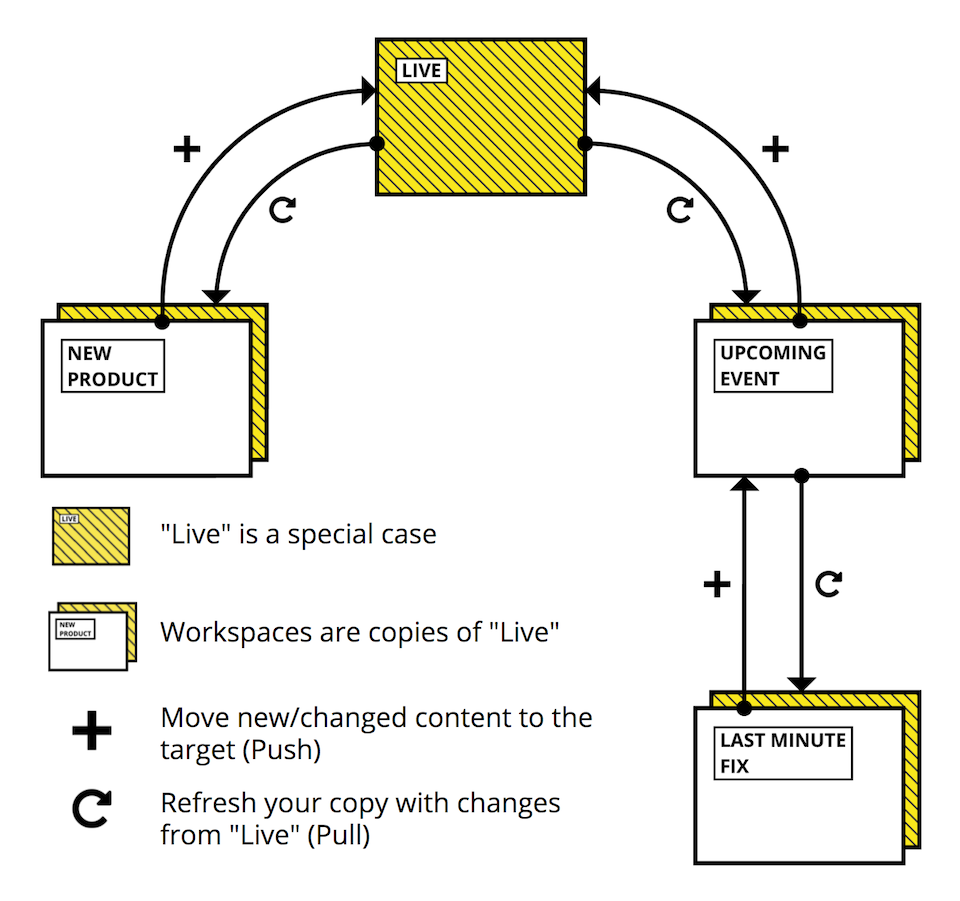
Source: Drupal.org
After applying all changes and ensuring that the final result meets expectations, workspaces can be deployed to the main version of the website. This makes content updates easier to control.
It is worth noting that in Drupal 11.1.0, the Workspaces module user interface has been moved to a separate module called Workspaces UI. This improvement increases the modularity of the system and gives users more flexibility in managing test environments.
Single Directory Components (SDC)
Another valuable feature in Drupal 11 is Single Directory Components (SDC). This is a new UI component system that allows frontend developers to keep all files for a single component in a single directory. For example, if we are creating our own "article tile" component, we can place its Twig template, CSS file, JavaScript, and configuration definition in a single folder. This greatly facilitates project organization and component reuse – such a folder can be easily moved between projects.
SDC is a stable feature in Drupal 11 that supports a component-driven development approach. Developers gain a clearer file structure and the ability to work on a component in isolation, which reduces the risk of errors.
Project Browser
Project Browser is a new functionality in the core of Drupal 11 that simplifies the installation and management of modules, themes, and ready-made configurations. With this tool, users can browse available extensions directly from the administrative interface without having to use Composer or other command line tools.
The intuitive interface built into Project Browser makes it easy to filter, search, and install selected projects. This module not only saves time but also lowers the barrier to entry for new Drupal users who are not necessarily technically savvy.

Source: Drupal.org
Since Drupal 11.1.0, Project Browser has gained additional improvements, including more precise module filtering, an improved recommendation system, and better integration with Drupal Recipes, allowing you to implement complete feature sets even faster.
Automatic Updates
Automatic Updates is one of the key new features in Drupal 11, significantly improving the convenience of website management and security. With this feature, the system automatically installs security patches and other important updates to the Drupal core without the need for manual intervention by the administrator.
Automatic updates enable faster response to threats and ensure the continuity of website operation without interruptions caused by manual updates. In addition, since Drupal 11.1.0, it has been possible to automatically update not only the core but also selected modules and additional components, which further simplifies system management and reduces the workload of the administration team.
Experience Builder
Experience Builder (XB) is an innovative initiative that aims to revolutionize the way websites are created in Drupal through an intuitive "no-code" editor. XB allows users with no programming experience to build and style websites directly in their browser, similar to popular site builders such as Wix or Squarespace. Unlike the previous Layout Builder tool, Experience Builder not only allows you to arrange content, but also gives you full visual control over page components – from layouts to styling elements such as colors, fonts, and visual effects.

Editing the appearance of a component in Experience Builder. Source: Drupal Experience Builder - Part 1
Importantly, Experience Builder is not just a simple page builder. It is intended to integrate the advantages of Drupal, such as structured data, a permissions system, and component reuse, with the convenience of a graphical editor. Dries Buytaert (creator of Drupal) announced that the goal is to consolidate existing solutions (Paragraphs, Layout Builder, etc.) into one coherent tool. This will end fragmentation – currently, there are many ways to build content in Drupal, which can be confusing. Experience Builder is intended to become a unified, intuitive environment for creating landing pages, subpage templates, and even theme elements.
Currently, this module is available as an alpha version (0.7.0-alpha1, July 2025) and is actively being developed. The stable version of Experience Builder (1.0) is expected in fall 2025.
Navigation menu interface improvements
Improvements to the navigation menu interface in Drupal 11 are one of the significant enhancements focused on user and editor convenience. The new Navigation module — introduced as experimental — brings a vertical, expandable side menu to the left side of the admin panel. This menu can be customized: you can create your own navigation blocks and rebuild the layout from within the interface using Layout Builder, giving you more control over the structure of administrative screens. Submenus expand into full-height side panels, and on mobile devices, the menu is rendered as an overlay and automatically adjusts to the screen size.
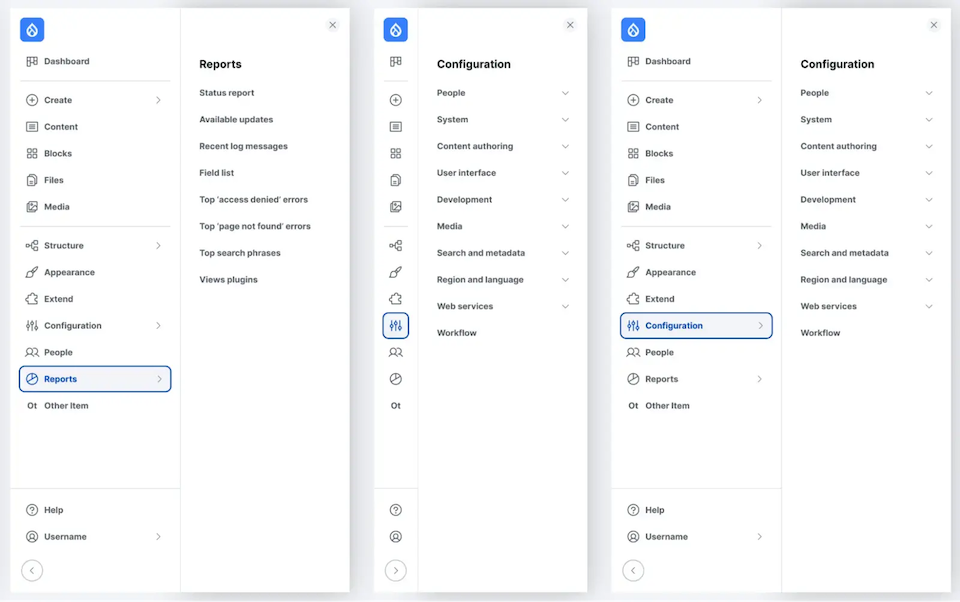
Source: Drupal.org
Access Policy API
The Access Policy API is one of the most important improvements in Drupal 11, introducing a policy-based approach (Policy-Based Access Control, PBAC) instead of the traditional role-based model (RBAC). This allows developers to define complex access rules using services, creating logic that is completely tailored to the needs of the project.
From now on, access no longer has to depend solely on the user's role. You can create conditional policies: for example, restrict access based on the current URL, time of day, user field values, domain, or any other environmental condition.
How does it work?
The entire Access Policy API process consists of two simple steps. In the first step (build), the system collects and establishes access rules from individual policies. In the second, optional stage (alter), additional changes can be made to restrict or modify previously granted permissions. The final result is then saved and cached in memory, which speeds up subsequent permission checks. Policies are created as services, so they can be easily enabled, disabled, or customized according to project needs.
Improved system performance
Drupal 11 also brings performance improvements to the website. The new version includes improvements such as optimized database queries, more efficient caching, and optimization of JS and CSS file usage. It is also important to note that the minimum required PHP version has been raised to 8.3 (version 11.1.0 introduces full support for PHP 8.4). All this means that websites running on the latest release of Drupal will run smoother and faster.
Drupal 11.1.0 also introduces the ability to use render caching for forms. This improvement significantly improves page loading speed, especially for high-traffic websites.
AI module
The AI module is Drupal's response to trends in the field of artificial intelligence. It enables integration with popular LLM (Large Language Models) such as OpenAI GPT, Anthropic Claude, Google Gemini, and local models by Ollama. The module acts as a unified abstraction layer – you can easily switch between different AI providers without changing your site configuration.
The most important applications of the AI module in Drupal 11 are automatic content generation – article titles, summaries, SEO tags, and alternative texts for images. The AI CKEditor module integrates artificial intelligence directly into the content editor, offering real-time suggestions and improvements. AI Search introduces semantic search using vector embeddings and RAG (Retrieval Augmented Generation) techniques for better search results.
The AI module ecosystem also includes AI SEO Analyzer (SEO analysis and optimization), AI Translate (contextual translation), AI Automators (field filling automation), AI Agents (autonomous agents for configuration management), and specialized tools such as README documentation generation and content moderation. The module also supports local AI deployments for organizations requiring full control over their data, providing flexibility in choosing between cloud and on-premises installations.
Drupal 11 - themes
Drupal 11 has also introduced significant changes in the area of themes. The default Claro administration theme has been significantly improved, offering an even more transparent, consistent, and accessible user interface. However, at the end of this year, the Claro theme is scheduled to be replaced by the popular Gin admin theme, which offers a more modern look, even greater clarity, and better ergonomics.
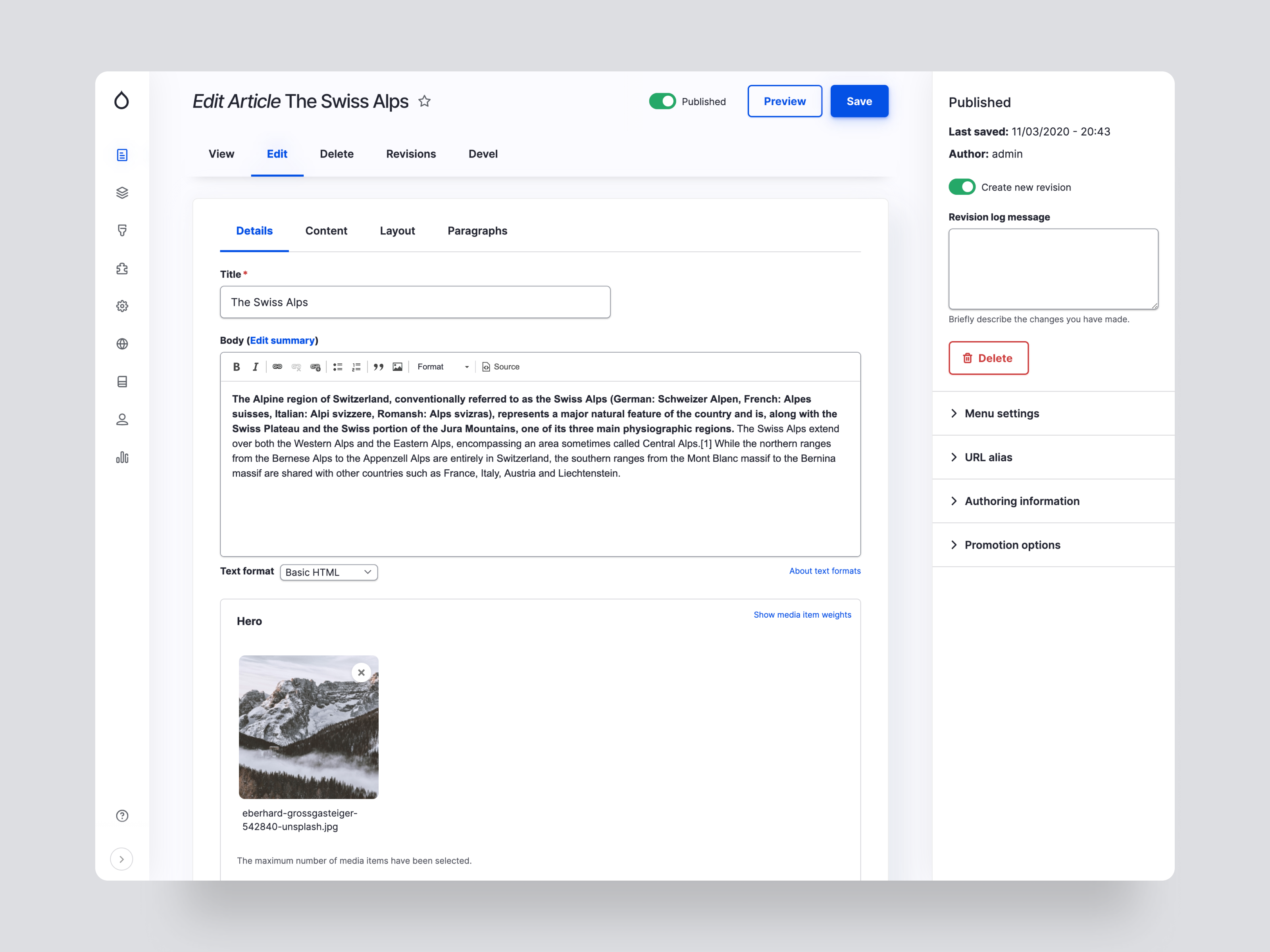
Source: Drupal.org
The Olivero frontend theme has been further optimized, particularly in terms of loading speed, accessibility, and support for modern web standards. With these changes, the themes in Drupal 11 provide users and website developers with a better visual experience and greater flexibility in creating custom designs.
Drupal CMS
Drupal CMS is the new official distribution of Drupal 11, released on January 15, 2025, and the culmination of an initiative formerly known as Starshot. Its goal is to simplify website operation and management as much as possible, especially for non-technical users. Drupal CMS combines the most innovative solutions, such as Experience Builder, Project Browser, and Recipes, to create a consistent, intuitive system for quickly creating and editing content.
Drupal CMS stands out with its set of extensive tools for customizing the appearance of pages, managing content, and integrating with external services. With Recipes, users can easily implement themed module sets, and Experience Builder allows for intuitive drag-and-drop content design. Project Browser, in turn, significantly simplifies extension management. The whole is complemented by an improved navigation system and a more flexible access policy mechanism (Access Policy API), making Drupal CMS a comprehensive solution for both beginners and advanced users.
Drupal 10 vs 11
The new version of Drupal brings many new features. So, how does it differ from Drupal 10?
- Some modules have been removed from the Drupal core to make it easier to maintain. These modules can still be installed. They are:
- Actions UI,
- Book,
- Tracker,
- Forum,
- Statistics,
- Tour.
- Drupal system requirements have been upgraded:
- Improved Admin UI
- More intuitive content moderation
Performance, search engine optimization, and accessibility have also been improved, making Drupal more enjoyable and efficient to use.
Installation and first steps – Drupal CMS, Droopler, Open Intranet
Now that we know what Drupal 11 has to offer, it's worth answering the question: how can you try it out for yourself? Fortunately, there are several easy ways to set up a local instance of Drupal 11 and ready-made distributions based on Drupal 11 that demonstrate its capabilities. Below are instructions for getting started with the most interesting options. We assume that you will use DDEV (a popular environment for quickly setting up local servers for Drupal) for local testing.
Drupal CMS locally
Drupal CMS is the new Drupal distribution (installation profile) mentioned earlier. This system's goal is to make it easier to get started, thanks to a simpler installer and pre-configured functions for common use cases (e.g., company website, blog, landing page).
To install Drupal CMS 1.2.0 locally using DDEV, follow these steps in the terminal:
git clone [email protected]:project/cms.git drupalcms
cd drupalcms
git checkout 1.2.0
ddev config --project-type=drupal11 --docroot=web
ddev start
ddev composer install
ddev launchThe above commands will clone the Drupal CMS code from the drupal.org repository, switch to version 1.2.0, configure the project for DDEV (drupal11 type), start the container, and install Composer dependencies. ddev launch should open your browser with the Drupal CMS installation wizard – just follow the few steps of the installer (set the site name, administrator account, etc.). After a moment, you will have a working Drupal 11-based website with sample content and all the new features ready to test.
Open Intranet locally
Open Intranet is a ready-made Drupal-based intranet solution developed by Droptica. It is a distribution of Drupal 10/11 that includes a knowledge base, document management, and company news – everything you need to create an internal company portal or community platform. Open Intranet demonstrates the capabilities of Drupal as the basis for an advanced intranet.
To run Open Intranet locally, you can use the included installation script. Execute the following commands:
git clone https://git.drupalcode.org/project/openintranet.git openintranet
cd openintranet
./launch-intranet.shThe launch-intranet.sh script will automatically download the necessary dependencies, launch containers (based on DDEV), and install the Open Intranet profile. When finished, a message should appear with the address where the intranet is available (e.g., https://openintranet.ddev.site). This is a great way to explore Drupal 11's capabilities in an intranet scenario without having to configure everything manually from scratch.
Droopler locally
Droopler is another Drupal distribution (maintained by Droptica) that serves as a corporate and marketing website builder. Droopler includes a set of ready-made visual components (called Paragraphs) for building company websites, landing pages, product offers, etc. Droopler has all the most important SEO features built in. With Droopler, you can create a modern website in just a few moments – it's a kind of "starter kit" for Drupal, with a ready-made graphic theme and sample content. Droopler is based on Drupal (currently version 10/11), which means that it has all the potential of Drupal Core under the hood, but right from the start, you get a configuration that speeds up the launch of a typical business website.
To install Droopler locally, run the following command in the terminal:
git clone https://git.drupalcode.org/project/droopler.git droopler
cd droopler
./launch-droopler-cms.shThe launch-droopler-cms.sh script, similar to the previous case, will take care of creating the environment and installing Droopler. Once completed, open the local address (e.g., https://droopler.ddev.site) – you will see a working Droopler-based website. Log in to the admin panel (by default via /user/login) to explore the prepared components and settings. Droopler demonstrates how Drupal 11 (and Paragraphs) can be used to build a flexible page builder for editors. You can add subpages, sections, banners, and galleries – all through a user-friendly interface.
Drupal 11 – summary
Drupal 11 is a significant step forward in the evolution of one of the most highly regarded content management systems. It has brought a number of important new features that significantly improve the user experience, performance, and security of websites. With features such as Automatic Updates, Experience Builder, Project Browser, and improved administrative interfaces, Drupal 11 has become more user-friendly for both non-technical and advanced users.
Another important element of Drupal 11 is the new distribution – Drupal CMS, which aims to create an intuitive environment for building and managing websites without the need to involve development teams for every minor modification. This initiative significantly lowers the barrier to entry for new users while providing advanced customization options for professionals.
Support for Drupal 10 is scheduled to end in 2026. Make plans now to move your website to the new version. Our team of Drupal developers will help you smoothly upgrade to Drupal 11.
***
Updated article dated 19/12/2024








